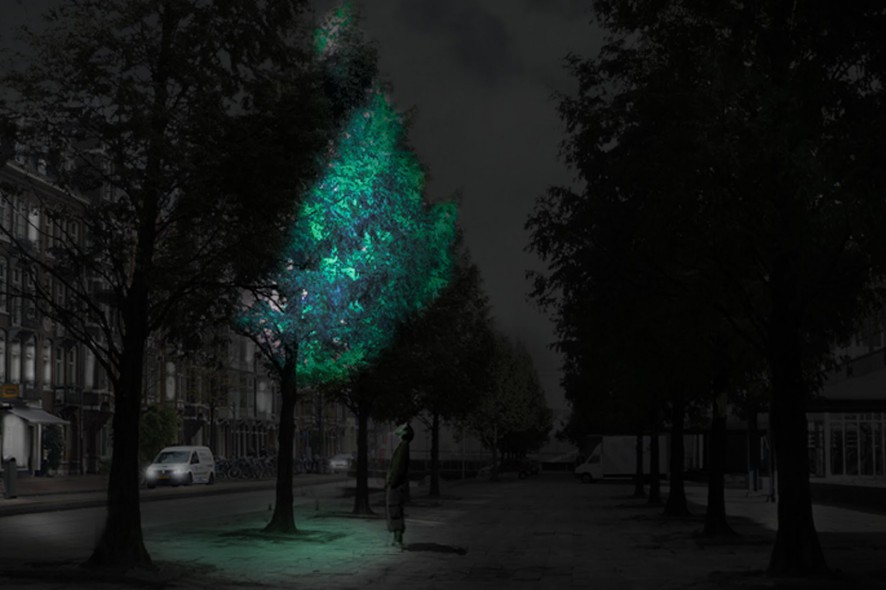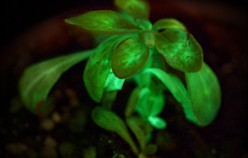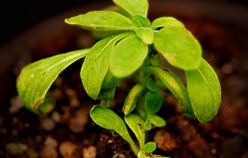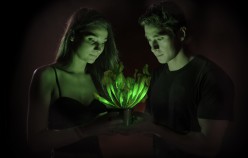“Biomimetic science studies how to transfer to the artificial world biological processes that naturally happen in nature. Man is inspired by nature and by imitating it can find solutions to various problems. The first person to refer to biomimetics was Leonardo Da Vinci when in his studies on flying machines he was inspired by how birds fly. Another example is the roof of the Crystal Palace in London, built in the mid-nineteenth century by the architect and botanist Joseph Paxton who was inspired by a water lily called Victoria Amazonica. But from the industrial revolution to now the scene has inevitably changed because the progress accomplished in the area of modern technology has brought new perspectives for connections between design and biology and offer new ways of interpreting nature.”
(Roberto Panzarani – centodieci.it)
The first bioluminescent plant, inspired by jellyfish and fireflies has been brought to life.
“Over time we have gradually removed ourselves from the natural world and repudiated the need for dependency on it. Science, which initially encouraged this separation process, is now proving that the consequences of this process can be harmful for us and for our biosphere. It is fundamental for our well-being that we recreate a connection with nature in all its sustainable aspects, bringing it to our cities and buildings in every way possible and at the same time increasing the sense of urbanity.”
(Peter Buchanan, Synchronizing with nature / DAmagazine, Autumn 2014).
If there is a designer who has brought this philosophy into his work, strongly believing in the value of light and the importance of illumination for our everyday life, it is Dean Roosegaarde.
He amazed everyone with his creation of a bicycle track illuminated with thousands of sparkling stones recalling Van Gough’s Starry Night, opened in Eindhoven in the Netherlands, Roosegaarde’s homeland, for the “Van Gogh International Theme Year 2015”.
The concept that deeply inspires all his work is focused on the determination to conceive urban environments where nature and technology can coexist side by side thus creating a dimension where awareness and interaction are foremost.
Of course these themes bond perfectly with the ever increasing need for sustainable and ecological solutions in art, architecture and urban development (from a social aspect). From this point of view, technology is no longer just an automated tool but it is transformed from being a ‘means’ to becoming an ‘end’. The project roadmap is inverted so if previously ideas were perceived and then a way to materialize them was studied, now a new scenario is designed and inspired by the means that will make it possible. It is therefore necessary to invert the binomial civilization-environment. The stereotype of a city that grows on the margins of nature has become obsolete, reclaiming spaces and tackling the borders to create a concept of nature that undermines the material project.
This happens in an innovative dimension: nature is not only a source of ornamental inspiration (like in the Art Nouveau period for example), it bears systems, organisms and solutions which are biologically accessible. This is how biomimetics began, a type of study that observes scientific matter and tries to find a sustainable solution to the continuous challenges of innovation and development by copying models, forms and strategies that already exist in the world of nature.
It is in this area that Roosegaarde decided to go in depth into the study of the possibility of exploiting the natural ability of some animals, like jellyfish and fireflies, to produce light without any help from external electricity or ultraviolet light. The first result, brought about thanks to the close work with the designers in the New York State University and the research centre Bioglow Tech, has led to the creation of a bioluminescent plant. The effect is amazing, the stem and the leaves of the small plant, genetically modified by introducing the DNA of electroluminescent bacteria in the genome of a common plant, emit a faint luminescent glow. It goes without saying that further development of this project is destined to revolutionise the world of lighting design.
Glowing Nature Paint
There is also another project that the Dutch designer is developing called Glowing Nature Paint, it is evident that he is fascinated or even more so, obsessed with light in nature. This project refers to the creation of biological paint which when applied to the bark of a tree and its leaves, makes them luminescent. This biological paint which is harmless for the tree, charges during the day and then emits bioluminescent light during the night.
-“Bioluminescent forest” work of Tarek Maward e Friedrich van Schoor.-
He was inspired by a particular type of mushroom (for example Neonothopanus gardneri, one of the biggest and most luminous florescent mushrooms) that during the night glows to attract insects thus dispersing its spores effectively.
A part from these projects which can be more or less achievable, from this information we can see that there is a clear drive towards retrieving what is extraordinary in nature and applying it to well-being and sustainability, which is widespread among visionaries at the helm of urban planning. We all hope that we are far from the day when our plant will not be habitable but this is certainly the way forward for the realization of sensible projects and let’s not forget what Albert Einstein wrote: “Everything you can imagine, nature has already created.”
And if he said it…

 English
English Italiano
Italiano












